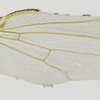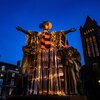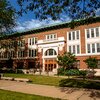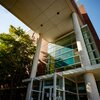
Contact Information
601 S Goodwin Ave C626
Urbana IL 61801
Research Interests
Research Topics
Development, Pattern Formation, Regulation of Gene Expression, Signal Transduction
Disease Research Interests
Trauma, Bleeding & Tissue Regeneration
Research Description
Wound repair and tissue regeneration; Drosophila genetics; Development and patterning
After wounding or injury some organisms, tissues and organs carry out an elegant process of regeneration to repair and replace the lost tissue. By studying model systems that regenerate well we can understand the mechanisms that promote regeneration and use them to manipulate healing and re-growth in critical human organs.
The process of regeneration involves a series of steps, each of which is poorly understood. Some outstanding questions are:
- How does a tissue sense damage?
- How does a damaged tissue initiate new growth?
- How is regenerative growth constrained so that it replaces only what was lost?
- How are cell fates properly specified within the new tissue?
- Does regeneration mimic development? If not, why?
- Are there regeneration-specific growth and patterning mechanisms that are required to replace the lost structure?
My lab aims to answer these questions using the regeneration of a simple epithelial tissue, the wing imaginal disc, in the model organism Drosophila melanogaster.
We use genetic tools to induce tissue damage and regeneration in the developing Drosophila wing. Using this method we can induce tissue damage and regeneration in hundreds of animals simultaneously, enabling high-throughput experiments, forward genetic screens, and genomic approaches to identify the genes and mechanisms that regulate each step in regeneration.
Current projects in the lab:
- Patterning and Development. We are characterizing expression of developmental patterning genes in regenerating tissue to determine the extent to which regeneration mimics development. When regeneration deviates from normal development, we are trying to understand how and why. We are also characterizing genes that are required for cell fate and pattern during regeneration but not during normal development (see Schuster and Smith-Bolton, Developmental Cell 2015).
- Chromatin. We are exploring how tissue damage induces the changes in gene expression that drive regeneration. We have focused on chromatin modifiers and remodeling complexes as key regulators of specific aspects of regeneration and subsets of regeneration genes.
In addition, the novel regeneration genes identified in our genetic screen and transcriptional profiling are leading us in exciting new directions. Stay tuned!
Education
B.A., Harvard University
Ph.D., Stanford University
Postdoctoral fellow, University of California Berkeley
Awards and Honors
2018-2019 I. C. Gunsalus Scholar
Roy J. Carver Charitable Trust Young Investigator Award
Arnold O. Beckman Research Award
Additional Campus Affiliations
External Links
Highlighted Publications
Tian, Y., & Smith-Bolton, R. K. (2021). Regulation of growth and cell fate during tissue regeneration by the two SWI/SNF chromatin-remodeling complexes of Drosophila. Genetics, 217(1), [iyaa028]. https://doi.org/10.1093/GENETICS/IYAA028
Fox, D. T., Cohen, E., & Smith-Bolton, R. (2020). Model systems for regeneration: Drosophila. Development (Cambridge), 147(7), [173781]. https://doi.org/10.1242/dev.173781
Abidi SNF, and Smith-Bolton RK. (2018). Cell fate changes induced by a Distal-less enhancer-trap transgene in the Drosophila antennal imaginal disc. Sci Rep 8:4950. doi:10.1038/s41598-018-23093-z
Khan SJ, Abidi SNF, Skinner A, Tian Y, Smith-Bolton RK (2017) The Drosophila Duox maturation factor is a key component of a positive feedback loop that sustains regeneration signaling. PLoS Genet 13(7): e1006937. https://doi.org/ 10.1371/journal.pgen.1006937
Brock AR, Seto M, Smith-Bolton RK. (2017) Cap-n-collar Promotes Tissue Regeneration by Regulating ROS and JNK Signaling in the Drosophila Wing Imaginal Disc. Genetics. July 1, 2017. 206(3): 1505-1520. https://doi.org/10.1534/genetics.116.196832
Sumbul Jawed Khan, Keaton J Schuster, and Rachel K. Smith-Bolton. (2016). Regeneration in Crustaceans and Insects. eLS. http://onlinelibrary.wiley.com/doi/10.1002/9780470015902.a0001098.pub2/…
Sumbul Jawed Khan*, Syeda Nayab Fatima Abidi*, Yuan Tian, Andrea Skinner and Rachel K. Smith-Bolton. (2016). A rapid, gentle and scalable method for dissociation and fluorescent sorting of imaginal disc cells for mRNA sequencing. Fly. http://www.tandfonline.com/doi/full/10.1080/19336934.2016.1173296
Andrea Skinner, Sumbul Jawed Khan, and Rachel K. Smith-Bolton. (2015). Trithorax regulates systemic signaling during Drosophila imaginal disc regeneration. Development 142: 3500-3511 http://dev.biologists.org/content/142/20/3500
Keaton J. Schuster and Rachel K. Smith-Bolton. (2015). Taranis protects regenerating tissue from fate changes induced by the wound response in Drosophila. Developmental Cell. 34(1): 119-128. http://dx.doi.org/10.1016/j.devcel.2015.04.017
Rachel K. Smith-Bolton. (2014). Drosophila imaginal discs as a model of epithelial wound repair and regeneration. Advances in Wound Care. doi:10.1089/wound.2014.0547.
Rachel K. Smith-Bolton, Melanie Worley, Hiroshi Kanda, and Iswar K. Hariharan. (2009). Regenerative growth in Drosophila imaginal discs is regulated by Wingless and Myc. Developmental Cell. 16(6): 797-809.
Recent Publications
Abidi, S. N. F., Hsu, F. T. Y., & Smith-Bolton, R. K. (2023). Regenerative growth is constrained by brain tumor to ensure proper patterning in Drosophila. PLoS genetics, 19(12), Article )e1011103. https://doi.org/10.1371/journal.pgen.1011103
Tian, Y., & Smith-Bolton, R. K. (2021). Regulation of growth and cell fate during tissue regeneration by the two SWI/SNF chromatin-remodeling complexes of Drosophila. Genetics, 217(1), Article iyaa028. https://doi.org/10.1093/GENETICS/IYAA028
Fox, D. T., Cohen, E., & Smith-Bolton, R. (2020). Model systems for regeneration: Drosophila. Development (Cambridge), 147(7), Article 173781. https://doi.org/10.1242/dev.173781
Abidi, S. N. F., & Smith-Bolton, R. K. (2018). Cell fate changes induced by a Distal-less enhancer-trap transgene in the Drosophila antennal imaginal disc. Scientific reports, 8(1), Article 4950. https://doi.org/10.1038/s41598-018-23093-z
Brock, A. R., Seto, M., & Smith-Bolton, R. K. (2017). Cap-n-Collar promotes tissue regeneration by regulating ROS and JNK signaling in the drosophila melanogaster wing imaginal disc. Genetics, 206(3), 1505-1520. https://doi.org/10.1534/genetics.116.196832




